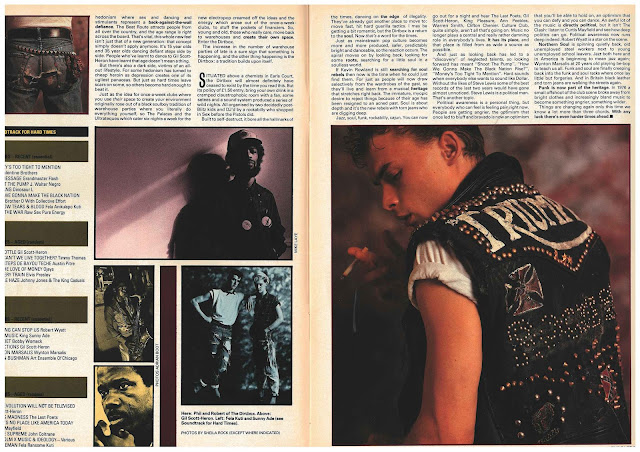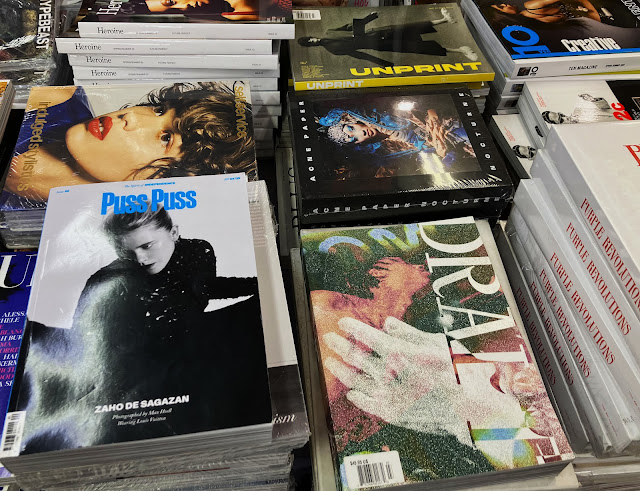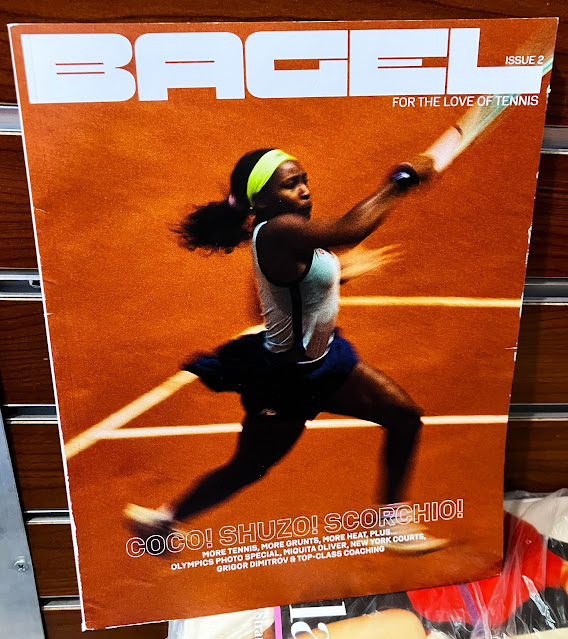Both magazines were done on a meagre budget yet managed to concoct this mirage of hip London that they transmitted all across the country and indeed internationally. (Joy bought both religiously).
If you look at an old issue now, especially early on, you can see how Face and iD were cobbled together in a last-minute dash just like the music papers. All kind of no-hope chancers getting featurettes, completely forgotten groups and motormouth types hawking something or other.
I remember Kodwo Eshun - I had no idea then who he was going to become! - came up to interview me (supposedly for the Oxford student mag Cherwell - I think he just wanted to meet). During a lively conversation at an outdoor table in Endell Street, he expressed disappointment that we hadn't gone straight from Monitor to The Face and iD. Like it hurt him to have to pick up a copy of Melody Maker every week, this broadsheet that left ink on your fingers.
But I rather liked the idea of operating from this supposedly clapped-out, obsolesced institution, going against the grain of times. (When the grain of the times was things like Absolute Beginners).
Besides, the format was in alignment with what we were pushing - a resurgent rock underground.
Also the music papers came out 51 times a year, whereas the style mags came out monthly. So there was just vastly more space for our verbosity to frolic in.
I should imagine it was very hard for a freelancer writing for a style magazine to make enough to live on, given you only have 12 paydays a year. And I seem to remember the iD word rate was modest, no better and possibly worse than the frightful word-rate at MM. At MM, if you were prolific and voluble, you could make a nice living as a freelancer, simply because there was so much space to fill.
The 51 issues (Xmas a double, lasted a fortnight) enabled you to construct more of an ongoing world.
That's what all these magazines were about - world creation, world maintenance.
I miss that. Is there any publication today, print or online that does that?
Well, No Bells does. They have meet-ups, events where people read music criticism aloud. It's a social space, not just a disembodied discourse space. The magazine is a locus of vibe.
Talking of style bibles, on a recent trip to New York, we went into a store that was choc-a-block with magazines into cutting edge fashion. Sort of modern day equivalents to iD and Face (both of those still going of course, as print entities - and bigger than ever in a literal sense - each issue is a monstrous paving stone of glossy fashion spreads, adverts, something you could injure yourself with if you picked it up without bending your knees properly, or injure someone else with, if wielded as weapon.)
I was staggered by how many of these style magazines there were - piled up everywhere, not an inch of space in this hipster newsagent I guess. From all over the world, with Steve McQueen-esque ugly-as-beauty images on the front.
Rather like with art books, I wondered what the financial and production logistics are when doing a magazine like this - quality paper stock, full gloss ultra-vivid images. The bottom line.
Do all the photographers and models and make-up and styling people just work for free in the hope of furthering their careers?
Advertising must bring in some money, from fashion and beauty products and trendy shit. But the cost of doing something so luxurious looking and feeling, and in presumably quite small print runs, must be enormous. And then the physical cost of distributing something so bulky. The shops must take a hefty mark-up given the amount of sheer volume each issue takes up.
Also rather like with art books, I wondered who actually buys these things,... They seemed to be retailing anywhere from $20 to $40 bucks each. I have a mental block with paying that for a magazine.
So I guess very rich people, or cutting edge fashion obsessives (same difference?).
And they doubtless function less as something to actually read and more like a coffee table book. Something to flick through desultorily or just have sitting there.
Still mystified by the title of this sports-as-style-microculture magazine
^^^^^^^^^^^^^^^^^^^^^^^
Paul Oldfield fires a salvo at The Face on the occasion of its 100th isssue.
And also analyses Neville Brody's work.
^^^^^^^^^^^^^^^^^^^^^^^^
Wandering around NYC I was amazed how saturated everywhere was with fashion advertising. I mean, yes it's always been there, but it was really kind of total in places like SoHo. Enormous, glossy images. Everything hyper-real and supersaturated. Often on LED screens rather than just posters.
Was also startled by the fashionization of Dr. Martens
I remember in the 1980s having to going to a rather poky, plain shop next to Camden tube station to get DMs. The kind of place that would do shoe repairs and cut keys as well as sell shoes. (Actually I might be imagining that aspect but it certainly had nothing fashion boutiquey about it).
DMs were "cool" through the skin and punk connection, but they still had some kind of residual currency as practical footwear, the kind of thing someone who worked in a factory or on a building site might wear for protection against things falling on the foot.
I expect this chic-ification has been going on for a while and I hadn't noticed.
Our kid asked for a pair of DMs some years ago and only wore them once - I was furious. They cost about $130.
^^^^^^^^^^^^^^^^^
"the treacherous Elms"
Carlyle had this type figured a century plus earlier
"First, touching Dandies, let us consider, with some scientific strictness, what a Dandy specially is. A Dandy is a Clothes-wearing Man, a Man whose trade, office, and existence consists in the wearing of Clothes. Every faculty of his soul, spirit, purse, and person is heroically consecrated to this one object, the wearing of Clothes wisely and well: so that as others dress to live, he lives to dress. The all-importance of Clothes, which a German Professor, of unequalled learning and acumen, writes his enormous Volume to demonstrate, has sprung up in the intellect of the Dandy without effort, like an instinct of genius; he is inspired with Cloth, a Poet of Cloth. What Teufelsdröckh would call a 'Divine Idea of Cloth' is born with him; and this, like other such Ideas, will express itself outwardly, or wring his heart asunder with unutterable throes."
^^^^^^^^^^^^^^^^^^^^^^^^^^^
R.Elms makes a cameo in this report on Marxism Today's 1986 conference on the Left's problem with style and hedonism for its own sake




























The shoe shop next to Camden tube station was Holts. Rather wonderfully, their only other outlet was in the poky north London suburb where I lived & I shopped there as a pre-teen in the late 70s. One could get away with eight-hole boots at my primary. As it happens, Robert Elms grew up about two miles away. Not sure that he would've ever crossed the threshold at Holts though. Unfortunately, the shop ensured that the area was a magnet for skins.
ReplyDeleteBizarre to think there was once only two places in London where you could get DMs.
DeleteI never read Robert Elms much, but I always enjoyed him on youth TV shows, even though his entire project seemed designed specifically to exclude me and people like me.
ReplyDeleteHe also earned respect for dating Sade Adu: a great partnership of artist and critic.
And those Spandau Ballet sleeve notes are all-time classics for the gap between discourse and reality. The rhetoric is exhilarating, but the music on that album - with the honourable exception of ‘To Cut a Long Story Short’ - lags far behind the Associates, Simple Minds, the Human League or even Ultravox.
Yeah if he'd written that about the Associates, I'd probably think it was spot on. Billy McKenzie and Alan Rankine had a whole thing about sport and physical fitness - that's why they are in the starting position on an athletic track on the cover of that first cover. Mens sana in corpore sano or whatever the saying it is. "I am beautiful and young and so very very clean" would be definitely an Associates sentiment. Could imagine DAF also getting behind it.
DeleteHaha I think the comment about the neglected $130 DMs must be the most Dad-core thought ever posted on this blog! I can identify.
ReplyDeleteHa! I think he ended up giving them to a friend.
DeleteThe American parallel to DMs that I find fascinating is Carhartt. Workwear that similarly became famous as affordable fashion through being championed by cool musicians.
ReplyDeleteTo capitalise the company launched a fashion line sold in completely different types of shop. It seems to be mostly similar styles to the workwear, but made at lower quality and sold at five times the price.
Re. The Face, they were the ones who alleged that Tony Wilson said if a Happy Monday were to die, it'd bring them as much success as Ian Curtis' death did for New Order. Tony Wilson always denied saying this, and threatened to sue. According to Tony Wilson's account (and this probably should with a caveat or two), The Face dithered his lawyers about for yonks, saying they had a recording, but couldn't find it. When the statute of limitations had passed (Wikipedia says it's a year for libel), The Face admitted to Wilson that they'd made it up. By the by, in Energy Flash you mentioned that quote without including Wilson's denial, which really cheesed my onions. (Jason Donovan successfully sued The Face in 1992 for implying that he was gay.)
ReplyDeleteGrowing up in a small Welsh town, I don't recall ever seeing The Face on newsagent shelves anywhere. It seems even more London-centric than Time Out. Even Kerrang! had good claim to be more representative of a wider, more populated demographic. (Speaking of which, Kerrang! at its peak was also a weekly? Would you claim that the writers similarly used the space to construct their own worlds?)
What the bloody hell is going on with the cover of that Fucking Young magazine on the stall?
Anyway, any excuse for this: https://www.youtube.com/watch?v=Vou_Ani-lKE
Yes The Face was Londoncentric absolutely - I think when the Hacienda etc took off it kind of threw them for a loop. R.Elms said some infamously dismissive things about Northerners. They were also a bit thrown for a loop by rave because it was as much a suburban phenomenon as inner city. Essex was a stronghold. It was also gloriously uncool and non-snooty.
DeleteThe Face sold to people in the sticks who desperately wished to get to London and be part of that clubland fantasy. And people worldwide for whom London was the coolest place on the planet.
I never saw the AHW denial so that's why it's not included.
DeleteTbh, it does really sound something he would say, as a wisecrack - and the jokey tone would get lost in cold hard print.
Isn't that piece by Nick Kent? Not 100 % sure of this, but I believe he never recorded interviews, relied on memory. Which is something that quite a few journalists do where the story involves hanging out with people rather than formal sit-down interviews. You can't have a tape recorder on constantly. Maybe you nip off to scribble something down in your notepad while in the bog. But a lot of the quotes are reconstructed from memory.
Kent in fact notoriously wrote up his stories by hand on scraps of paper, anything to hand. And then brought them in the magazine office in a chaos of bits. But I would also trust his memory on the whole.
At any rate, Kent understood (like Nik Cohn) that music journalism is not really journalism in the news reporting sense - it's myth-mongering. Why get in the way of a good story? It's rock and roll - there's no such thing as bad publicity.
ReplyDeleteKerrang is very much in the business of world-creation. Any successfully vibey mag with a loyal readership is about that - Private Eye, probably The Spectator, Punch. Creem in America.
It conjures a world that you would like to partake of.
Kerrang' s world is not one I would want to join, but good luck to those who do.
There used to be a metal mag in the States called Decibel that had a very strong vibe - such that you could enjoy reading even if you had minimal interest in metal.
People used to come to visit the Melody Maker pub the Oporto, because the paper had made it seem like the epicentre of rock, where all the bands were to be found. Then they'd be disappointed when they got there - "is that it?". It was just a poky and plain little watering hole, the only thing in its favour was that it was conveniently close to the office - physically part of the same building in fact
Think that tennis mag with Coco Gauff on the cover is is called Bagel as that’s a term used when somebody loses a set 6-0. They got bageled.
ReplyDeleteOn the price of those magazines, yeah it’s even worse in Ireland with import costs, retailer markups, VAT etc. I always wonder how the hell do all these high gloss fashions and interior design / House / Garden mags make any money with the minuscule amount of people who buy them in the internet age. Same with the one off artist music mags that Mojo and Uncut put out. They’re nice to flick through at the newsagents but ridiculously priced when you could buy a book instead.
Advertising, basically. The economic model of most magazines depends on advertising space, product placement and the like, not on the money the reader pays. In other words, the reader is not the consumer, but the product. Viewed with that light, such high-end magazines seek to proffer a wealthy clientele to the advertisers, and as such charge accordingly. There's no point in, say, Ferrari advertising their wares to shop assistants, so there's no point in seeking mediums of advertisement with low barriers to entry. The market naturally leads luxury goods manufacturers to spend fuckloads on glossy ads intended only to be seen by a few rich twats. This also explains why advertising on Youtube and such is so shoddy: even price-conscious consumers can see it, so why waste time, effort and money trying to sell a £10,000 watch to someone on minimum wage? Along with that, it also explains why so much advertising on the internet is for scams: it's con artists exploiting a vanishingly low barrier to entry to target the vulnerable. If you're interested in learning more of the theory behind this, look up George Akerlof and his work on information asymmetry.
DeleteMind, plenty in the advertising industry believe that internet advertising just doesn't work, that consumers loathe the intrusions, the poor quality and the scams, and that the internet advertising sector is just a massive bubble waiting to pop. Note also that one of the vanishingly few magazines to have increased its revenue/readership in the internet age is Private Eye, which puts almost none of its content online.
Bagel - well you learn something every day!
DeleteThat ‘Blitz’ book looks like it will tread a lot of the same ground as the ‘Sweet Dreams’ oral history book Dylan Jones put out in 2020. Elms himself was quoted a fair bit in that.
ReplyDeleteI was interviewed by Elms on his London Radio show around Energy Flash - this is 1998 - and he was insistent that the English working class love affair with Black American music had ended with rave... seemingly oblivious to its origins in Black Detroit and Black Chicago and Black New York.... let alone jungle which is you know pretty darn MOBO-y.
ReplyDeleteHe kept watching the cricket on a little TV on the wall all through our live broadcast chat.... a Test Match I think
Have just read the relevant pages in Elms' The Way We Wore about the coming of rave (ie Shoom). He seems to vacillate between knowing that things were insufferably elitist and had to change, and deep unhappiness that the barbarians are at the gate.
ReplyDelete